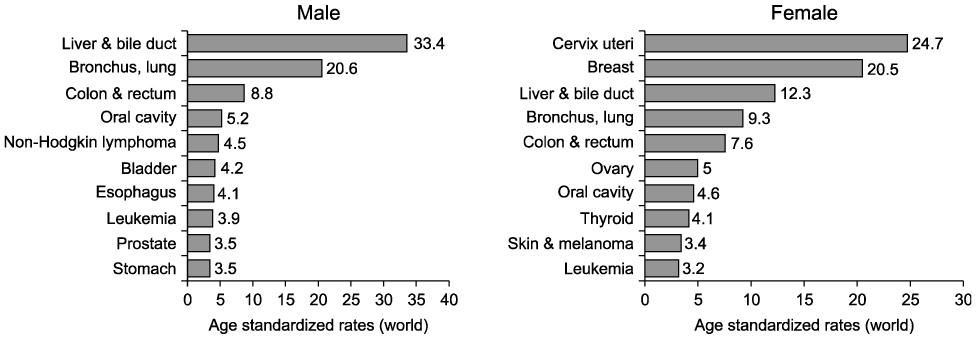J Gynecol Oncol.
2009 Jun;20(2):81-83. 10.3802/jgo.2009.20.2.81.
Epidemiologic report of gynecologic cancer in Thailand
- Affiliations
-
- 1Division of Gynecologic Oncology, Department of Obstetrics and Gynecology, Ramathibodi Hospital, Mahidol University, Bangkok, Thailand. raswl@mahidol.ac.th
- KMID: 2245087
- DOI: http://doi.org/10.3802/jgo.2009.20.2.81
Abstract
- Cancer has been the most common cause of death in Thailand from 2002 (65.4/100,000/year in 2002). With regard to leading cancers in Thailand for female population, the highest incidence falls into cervical cancer (25/100,000/year) followed by breast, liver and bile duct, bronchus and lung, colon and rectum, and ovarian cancer. In 2003, there were 6,243 new cases of cervical cancer with the death of 2,620 women. Therefore, in Thailand, seven women die from cervical cancer each day. However, the incidence of cervical cancer in Thailand is decreasing. The important factor contributed to this decreasing is the implement of Thailand dual-track strategy cervical screening program using both Pap smear and visual inspection with acetic acid (VIA)-cryotherapy. Learning about the epidemiologic data of gynecologic cancer could raise public awareness and play a part in establishing measures for prevention, control and treatment of the cancer which will contribute to the better health of women, and of course, decrease the expense used in various modalities of treatment.
Keyword
MeSH Terms
Figure
Reference
-
1. Agar Charles. Frommer's Thailand. 2006. 2nd ed. Hoboken: Wiley Publishing, Inc.2. Khuhaprema T, Srivatanakul P, Sriplung H, Wiangnon S, Sumitsawan Y, Attasara P. Cancer in Thailand Vol. IV, 1998-2000. 2007. Bangkok: Ministry of Public Health, Ministry of Education.3. Data from the Ministry of Public Health, Thailand.4. Data from the Royal Thai College of Obstetricians and Gynecologists.5. Cancer Epidemiology Database, GLOBOCAN 2002 [Internet]. IARC. c2002. cited 2009 May 29. Lyon: International Agency for Research on Cancer;Available from: http://www-dep.iarc.fr/.6. Sriplung H, Sontipong S, Martin N, Wiangnon S, Vootiprux V, Cheirsilpa A, et al. Cancer in Thailand Vol III, 1995-1997. 2004. Bangkok: Bangkok Medical Publisher.7. Ramathibodi Cancer Registry, Faculty of medicine, Ramathibodi hospital, Mahidol University. Cancer report 2006.8. Ramathibodi Cancer Registry, faculty of medicine, Ramathibodi hospital, Mahidol University. Cancer report 2007.9. Ramathibodi Cancer Registry, faculty of medicine, Ramathibodi hospital, Mahidol University. Cancer report 2001-5.10. Sukvirach S, Smith JS, Tunsakul S, Munoz N, Kesararat V, Opasatian O, et al. Population-based human papillomavirus prevalence in Lampang and Songkla, Thailand. J Infect Dis. 2003. 187:1246–1256.11. Clifford GM, Gallus S, Herrero R, Munoz N, Snijders PJ, Vaccarella S, et al. Worldwide distribution of human papillomavirus types in cytologically normal women in the International Agency for Research on Cancer HPV prevalence surveys: a pooled analysis. Lancet. 2005. 366:991–998.12. Franceschi S, Herrero R, Clifford GM, Snijders PJ, Arslan A, Anh PT, et al. Variations in the age-specific curves of human papillomavirus prevalence in women worldwide. Int J Cancer. 2006. 119:2677–2684.
- Full Text Links
- Actions
-
Cited
- CITED
-
- Close
- Share
- Similar articles
-
- The epidemiologic status of gynecologic cancer in Thailand
- The 7th Biennial Meeting of the Asian Society of Gynecologic Oncology, November 25th to 27th, 2021
- The Annual Meeting of the Thai Gynecologic Cancer Society 2019: Meeting report
- Annual report of gynecologic cancer registry program in Korea: 1991~2004
- The 6th Biennial Meeting of the Asian Society of Gynecologic Oncology, October 10th to 12th, 2019


